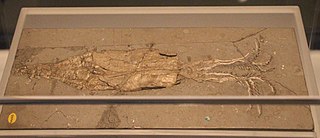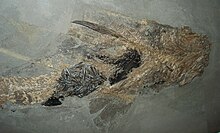
Coleoidea or Dibranchiata is one of the two subclasses of cephalopods containing all the various taxa popularly thought of as "soft-bodied" or "shell-less". Unlike its extant sister group Nautiloidea, whose members have a rigid outer shell for protection, the coleoids have at most an internal shell called cuttlebone or gladius that is used for buoyancy or as muscle anchorage. Some species, notably incirrate octopuses, have lost their cuttlebone altogether, while in some it has been replaced by a chitinous support structure. A unique trait of the group is the ability to edit their own RNA.

Belemnoids are an extinct group of marine cephalopod, very similar in many ways to the modern squid. Like them, the belemnoids possessed an ink sac, but, unlike the squid, they possessed ten arms of roughly equal length, and no tentacles. The name "belemnoid" comes from the Greek word βέλεμνον, belemnon meaning "a dart or arrow" and the Greek word είδος, eidos meaning "form".

Nautiloids are a group of marine cephalopods (Mollusca) which originated in the Late Cambrian and are represented today by the living Nautilus and Allonautilus. Fossil nautiloids are diverse and species rich, with over 2,500 recorded species. They flourished during the early Paleozoic era, when they constituted the main predatory animals. Early in their evolution, nautiloids developed an extraordinary diversity of shell shapes, including coiled morphologies and giant straight-shelled forms (orthocones). No orthoconic and only a handful of coiled species, the nautiluses, survive to the present day.

The phragmocone is the chambered portion of the shell of a cephalopod. It is divided by septa into camerae.

Orthocerida, also known as the Michelinocerida, is an order of extinct orthoceratoid cephalopods that lived from the Early Ordovician possibly to the Late Triassic. A fossil found in the Caucasus suggests they may even have survived until the Early Cretaceous, and the Eocene fossil Antarcticeras is sometimes considered a descendant of the orthocerids although this is disputed. They were most common however from the Ordovician to the Devonian.

The Bactritida are a small order of more or less straight-shelled (orthoconic) cephalopods that first appeared during the Emsian stage of the Devonian period with questionable origins in the Pragian stage before 409 million years ago, and persisted until the Carnian pluvial event in the upper middle Carnian stage of the Triassic period. They are considered ancestors of the ammonoids, as well as of the coleoids.

Octopodiformes is a superorder of the subclass Coleoidea, comprising the octopuses and the vampire squid. All living members of Octopodiformes have eight arms, either lacking the two tentacles of squid or modifying the tentacles into thin filaments. Octopodiformes is often considered the crown group of octopuses and vampire squids, including all descendants of their common ancestor. Some authors use the term Vampyropoda for the same general category, though others use "Vampyropoda" to refer to the total group. Another term is Octobranchia, referring to cephalopods without prominent tentacles.
Aulacocerida is an order of primitive coleoid cephalopods, possibly derived from michelinoceraitids (Orthocerida) early in the Devonian, which in turn gave rise to the Belemnites.
Boletzkyida is a primitive order of teuthid coleoid cephalopod: the boletzkyids are thought to be the earliest forms of coleoid cephalopods, and appear to form a link between nautiloid orthocerids and more advanced coleoids. Boletzkyida was named and described by Bandel, Reitner, and Sturmer in 1983 (B.R.&S) from specimens found in the Lower Devonian black slate in Germany.

Cylindroteuthis is a genus of belemnite that lived from the Early Jurassic to the Early Cretaceous. Its fossils have been found in Asia, Europe, North America, and New Zealand.

Belemnitella is a genus of belemnite from the Late Cretaceous of Europe and North America. Belemnitella was a squidlike animal, probably related to the ancestors of modern squids and cuttlefish. The shell was internal. The rostrum or guard is found the most often and possesses a distinctive slit at its ventral surface and a ridge on the dorsal surface. The phragmocone has a small protoconch at its tip, and fit into the cavity and the guard. It also had septa and a ventral siphuncle within the phragmocone, projecting forward as a beak-like blade.

Belemnotheutis is an extinct coleoid cephalopod genus from the middle and upper Jurassic, related to but morphologically distinct from belemnites. Belemnotheutis fossils are some of the best preserved among coleoids. Remains of soft tissue are well-documented in some specimens, even down to microscopic muscle tissue. In 2008, a group of paleontologists even recovered viable ink from ink sacs found in several specimens.

Phragmoteuthis is a genus of extinct coleoid cephalopod known from the late Triassic to the lower Jurassic. Its soft tissue has been preserved; some specimens contain intact ink sacs. It had an internal phragmocone and an unknown number of arms.

Acanthoteuthis is a belemnite genus, a squid-like cephalopod with an internal shell from the Late Jurassic Epoch, related to modern coleoids.

Belemnitina is a suborder of belemnites, an extinct group of cephalopods. They have been identified as the oldest of all the belemnites and are likely the stockgroup for them. They were extant from the early Jurassic to the early Cretaceous. Their geographic distribution was mostly limited to Europe, although specimens have been described in Japan suggesting they may have been more widespread than previously thought.

Neocoleoidea is a large group of marine cephalopods. This cohort contains two extant groups: Decapodiformes and Octopodiformes. Species within this group exist in all major habitats in the ocean, in both the southern and northern polar regions, and from intertidal zones to great depths. Whilst conventionally held to be monophyletic, the only morphological character for the group is the presence of suckers: although the presence of these features in the belemnites suggests that they do not support the Neocoleoidea, and hence that the group may be paraphyletic.
The cephalopods have a long geological history, with the first nautiloids found in late Cambrian strata, and purported stem-group representatives present in the earliest Cambrian lagerstätten.

Phragmoteuthida is an order of extinct coleoid cephalopods characterized by a fan-like teuthoid pro-ostracum attached to a belemnoid-like phragmocone.

Clarkeiteuthis is a genus of extinct belemnoid cephalopod known from the lower Jurassic in Germany and England. Described two species, C. conocauda and C. montefiorei are originally described as species of phragmoteuthid Phragmoteuthis, but got their own genus and moved to Diplobelida.
Antarcticeras is an extinct genus of enigmatic cephalopod from the Eocene of Antarctica. It contains a single species, A.nordenskjoeldi. It is either considered the last of the "orthocone"-type cephalopods, the only member of its subclass Paracoleoidea & a descendant of the orthoceratids, and a remarkable example of convergent evolution with coleoid cephalopods, or an oegospid squid and a transitional form in the development of the modern squid gladius, of which it is the only preserved example.





























